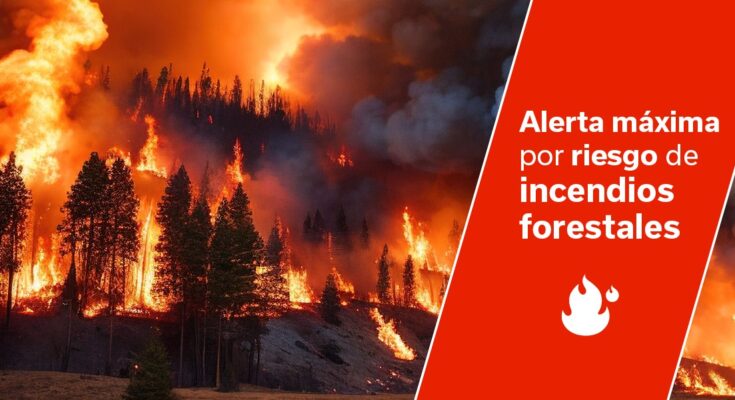
Alerta de bandera roja (clima propicio para incendios
Alerta de bandera roja (clima propicio para incendios) In regions prone to wildfires, the issuance of a red flag warning signals heightened weather conditions that are conducive to the rapid spread of fires. These warnings serve as critical alerts for communities, land managers, and emergency responders, highlighting the need for increased vigilance and preparedness to mitigate the risk of wildfires. In this article, we’ll explore the concept of red flag warnings, the weather conditions that prompt their issuance, and the importance of heeding these alerts to protect lives, property, and natural resources.
What is a Red Flag Warning?
A red flag warning is a specialized weather alert issued Alerta de bandera roja (clima propicio para incendios) by meteorological agencies to warn of conditions that may increase the likelihood or spread of wildfires. These warnings are typically issued in areas where dry, windy, and hot weather conditions combine to create a high risk of fire ignition and rapid fire spread. Red flag warnings are intended to alert residents, land managers, and emergency responders to the elevated fire danger and encourage proactive measures to prevent and suppress wildfires.
Weather Conditions Conducive to Red Flag Warnings
Several weather factors contribute to the issuance of red flag warnings, including:
- Low Humidity: Dry air Alerta de bandera roja (clima propicio para incendios) with low relative humidity levels increases the flammability of vegetation and accelerates the drying of fuels, making them more susceptible to ignition.
- High Temperatures: Elevated temperatures increase evaporation rates and contribute to the drying of vegetation and soil moisture, creating prime conditions for fire ignition and spread.
- Strong Winds: High winds can rapidly spread wildfires by carrying embers and burning debris long distances, creating spot fires ahead of the main fire front and increasing the intensity and speed of fire spread.
- Drought Conditions: Prolonged periods of drought reduce soil moisture levels, desiccate vegetation, and create tinder-dry conditions that are highly susceptible to ignition and rapid fire spread.
- Topography: Terrain features such as Alerta de bandera roja (clima propicio para incendios) steep slopes, canyons, and ridgelines can influence wind patterns and fire behavior, exacerbating fire spread and making containment efforts more challenging.
Impacts of Red Flag Warnings
Red flag warnings have significant implications for public safety, property protection, and natural resource management:
- Public Safety: Red flag warnings prompt communities to implement safety measures such as fire bans, evacuation orders, and restrictions on outdoor activities to reduce the risk of human-caused wildfires and protect lives and property.
- Fire Suppression Alerta de bandera roja (clima propicio para incendios) Resources: Emergency responders and firefighting agencies increase staffing levels, preposition firefighting resources, and coordinate response efforts in anticipation of heightened fire activity during red flag warning periods.
- Resource Protection: Land managers and conservation agencies implement measures to protect natural resources, including prescribed burns, fuel reduction projects, and habitat restoration efforts to minimize the impacts of wildfires on ecosystems and wildlife habitats.
- Economic Impact: Wildfires resulting from red flag warning conditions can have significant economic impacts, including property damage, loss of livelihoods, and disruption of critical infrastructure, agriculture, and tourism industries.
Preparedness and Mitigation Strategies
In response to red flag warnings, individuals and communities can take proactive measures to reduce the risk of wildfires and mitigate their potential impacts:
- Fire Prevention: Practice fire safety precautions such as properly extinguishing campfires, avoiding outdoor burning during red flag warning periods, and maintaining defensible space around homes and structures.
- Emergency Preparedness: Develop and maintain emergency evacuation plans, assemble emergency supply kits, and stay informed about local fire conditions and evacuation orders issued during red flag warning periods.
- Community Engagement: Participate in community wildfire preparedness efforts, support fire prevention initiatives, and collaborate with neighbors, local authorities, and firefighting agencies to enhance community resilience and response capabilities.
- Public Education: Educate yourself and others Alerta de bandera roja (clima propicio para incendios) about the dangers of wildfires, the importance of fire safety practices, and the significance of heeding red flag warnings to protect lives, property, and natural resources.
Conclusion: Responding to Red Flag Warnings
In conclusion, red flag warnings are vital tools for identifying and mitigating the risk of wildfires during periods of elevated fire danger. By understanding the weather conditions that prompt red flag warnings and taking proactive measures to reduce fire risk, individuals and communities can help prevent wildfires and minimize their impacts on Alerta de bandera roja (clima propicio para incendios)Alerta de bandera roja (clima propicio para incendios) lives, property, and ecosystems. Through collaboration, preparedness, and vigilance, we can work together to build resilient communities and landscapes that are better equipped to withstand the challenges of wildfire season and protect the places we call home.






